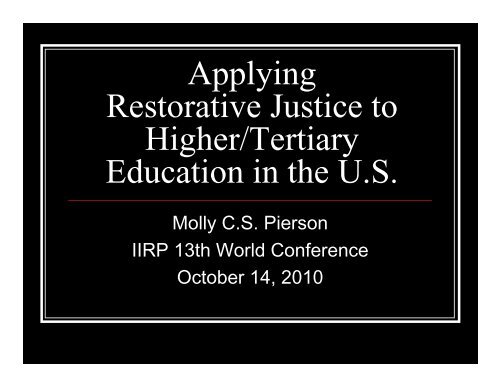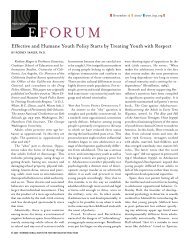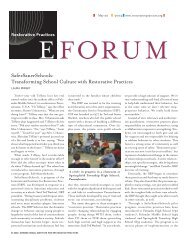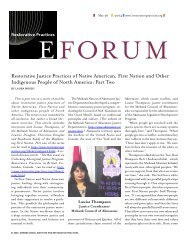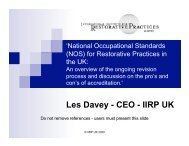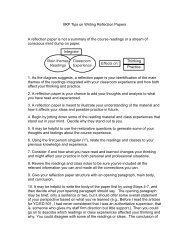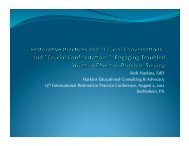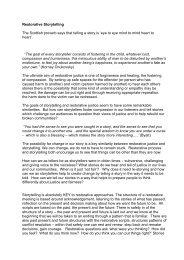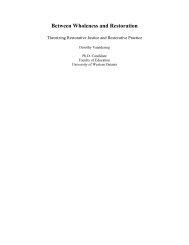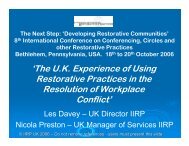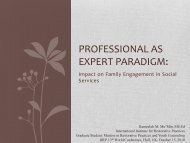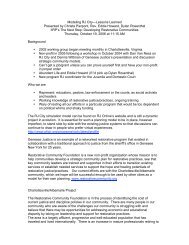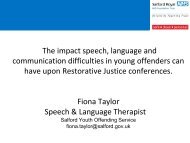Applying Restorative Justice to Higher/Tertiary Education in ... - IIRP
Applying Restorative Justice to Higher/Tertiary Education in ... - IIRP
Applying Restorative Justice to Higher/Tertiary Education in ... - IIRP
You also want an ePaper? Increase the reach of your titles
YUMPU automatically turns print PDFs into web optimized ePapers that Google loves.
<strong>Apply<strong>in</strong>g</strong><br />
<strong>Res<strong>to</strong>rative</strong> <strong>Justice</strong> <strong>to</strong><br />
<strong>Higher</strong>/<strong>Tertiary</strong><br />
<strong>Education</strong> <strong>in</strong> the U.S.<br />
Molly C.S. Pierson<br />
<strong>IIRP</strong> 13th World Conference<br />
Oc<strong>to</strong>ber 14, 2010
Overview<br />
Student Affairs <strong>in</strong> U.S. <strong>Higher</strong> <strong>Education</strong><br />
Judicial Affairs/Student Conduct<br />
University RJ Programs<br />
<strong>Res<strong>to</strong>rative</strong> <strong>Justice</strong>/Student Learn<strong>in</strong>g<br />
Community Circle Program, University of<br />
Michigan, Ann Arbor, U.S.
U.S. <strong>Higher</strong> <strong>Education</strong> Miles<strong>to</strong>nes<br />
Colonial Colleges<br />
Start<strong>in</strong>g with the found<strong>in</strong>g of Harvard 1636<br />
Land-Grant Institutions<br />
Gott v. Berea<br />
Dixon v. Alabama<br />
CAS Standards<br />
Student Learn<strong>in</strong>g Imperative
Judicial Affairs/Student Conduct<br />
Always misconduct<br />
Birth of formal judicial affairs/conduct<br />
personnel, 1961<br />
Discipl<strong>in</strong>ary legalistic conflict resolution<br />
Promote moral and ethical development<br />
Growth <strong>in</strong> complexity & formation of<br />
national organization
<strong>Res<strong>to</strong>rative</strong> <strong>Justice</strong> Programs <strong>in</strong><br />
U.S. <strong>Higher</strong> <strong>Education</strong><br />
Models: conduct boards, conferences, harmfocused<br />
conversations<br />
<strong>Res<strong>to</strong>rative</strong> Conferences: facilita<strong>to</strong>rs,<br />
respondent(s), harmed parties, respondent<br />
support<br />
Colorado State University, Judicial Office<br />
<br />
Victim/Offender <strong>Res<strong>to</strong>rative</strong> Conferences<br />
University of Michigan, Hous<strong>in</strong>g<br />
University of Colorado at Boulder, Municipal Connection<br />
<br />
<br />
Large student impact on surround<strong>in</strong>g <strong>to</strong>wn<br />
Representative harmed parties
<strong>Res<strong>to</strong>rative</strong> <strong>Justice</strong> & Student<br />
Learn<strong>in</strong>g<br />
Situat<strong>in</strong>g learn<strong>in</strong>g <strong>in</strong> the learner’s<br />
experience (Baxter Magolda 2004)<br />
One study found (Meagher 2009),<br />
Changed how they viewed themselves & others<br />
Feel<strong>in</strong>g of resolution<br />
Learned new <strong>in</strong>formation & skills<br />
Changed behaviors
Changed How They View<br />
Themselves & Others<br />
“It made me not as bitter <strong>to</strong> my neighbors<br />
that called either, ’cause when we were<br />
talk<strong>in</strong>g about everyth<strong>in</strong>g, it made me k<strong>in</strong>d of<br />
realize it was my fault. I wasn’t as much<br />
like, ‘I hate those neighbors. They need <strong>to</strong><br />
move out.’ . . . so it made me feel a lot<br />
more—put more blame on myself than “I<br />
hate them” k<strong>in</strong>d of th<strong>in</strong>g.” JAMIE
Feel<strong>in</strong>g of Resolution<br />
“It is a cleans<strong>in</strong>g process, and after you’re done, it<br />
won’t—I’m not gonna say it won’t be on your m<strong>in</strong>d<br />
ever aga<strong>in</strong>, but it is dramatically decreased, the<br />
amount of time that you spend th<strong>in</strong>k<strong>in</strong>g about like<br />
what happened what you would’ve done. And you<br />
know, I th<strong>in</strong>k that most people, when they do<br />
someth<strong>in</strong>g wrong, they have regrets, and they feel<br />
bad about the ways they’ve affected their own<br />
lives, but also other people that they’ve affected.<br />
So, mostly I would just say it’s just a cleans<strong>in</strong>g<br />
process. You feel a lot better com<strong>in</strong>g out the other<br />
end.” FARM BOY
Learned New Information &Skills<br />
“The res<strong>to</strong>rative process k<strong>in</strong>d of <strong>in</strong>stilled the<br />
notions of be<strong>in</strong>g a decent person, a civil<br />
human be<strong>in</strong>g, and sort of like a team<br />
player, like we’re all <strong>in</strong> this <strong>to</strong>gether, and<br />
through communication, we can work most<br />
of our problems out that we have and really<br />
move on from any mishaps or any<br />
unfortunate occurrences that have<br />
happened <strong>in</strong> the past.” BILLIAM
Changed Behavior<br />
“Like, I haven’t been <strong>in</strong><strong>to</strong> a fight s<strong>in</strong>ce, and, like I said<br />
before, I mean, I’ve been <strong>in</strong> quite a few . . . . Whereas,<br />
<strong>in</strong> the past, had that guy just said someth<strong>in</strong>’ <strong>to</strong> me like<br />
he did that night . . . when he made that racial remark<br />
<strong>to</strong>wards me, I woulda just hit him, you know, and I<br />
would’ve fought him, and I wouldn’t have thought<br />
about it, you know, for a second. But right <strong>in</strong> that<br />
moment, I was like, “This is not worth it.” You know, I<br />
thought beyond the fact that, like, “Okay, this guy’s<br />
just ignorant.” Like, “Whatever he has <strong>to</strong> say, you<br />
know, it doesn't matter.” So, it really changed me from<br />
that perspective.” ANTONIO
Community Circles Program,<br />
University of Michigan<br />
Hous<strong>in</strong>g/Residence<br />
<strong>Education</strong><br />
CLAM<br />
Student Facilita<strong>to</strong>rs<br />
Conference Model<br />
Howard Zehr &<br />
<strong>IIRP</strong> Conference<br />
Tra<strong>in</strong><strong>in</strong>g
UM Hous<strong>in</strong>g RJ His<strong>to</strong>ry<br />
<strong>Res<strong>to</strong>rative</strong> justice pr<strong>in</strong>ciples <strong>in</strong>fused <strong>in</strong> hous<strong>in</strong>g<br />
conflict resolution processes <strong>in</strong> 2003<br />
Pilot<strong>in</strong>g the Community Circles Program<br />
Recruited and tra<strong>in</strong>ed facilita<strong>to</strong>rs <strong>in</strong> Fall 2007<br />
Cases began <strong>in</strong> W<strong>in</strong>ter 2008 with 13 respondents<br />
S<strong>in</strong>ce then:<br />
Academic Year 2008-09 — 51 respondents<br />
Academic Year 2009-10 — 64 respondents<br />
Currently have 26 student facilita<strong>to</strong>rs<br />
Vander Velde, S., Gallagher, M., & Costa, A. (2010).
<strong>Res<strong>to</strong>rative</strong> <strong>Justice</strong> Pr<strong>in</strong>ciples<br />
Karp & Allena<br />
2004
Resolution Options <strong>in</strong> UM<br />
Hous<strong>in</strong>g<br />
Arbitration:<br />
One-on-One meet<strong>in</strong>g conducted by the hear<strong>in</strong>g officer<br />
with those who caused the harm (respondent) <strong>to</strong><br />
determ<strong>in</strong>e what res<strong>to</strong>rative measures can be taken <strong>to</strong><br />
the repair the harm committed.<br />
Community Circle:<br />
Group meet<strong>in</strong>g <strong>in</strong>volv<strong>in</strong>g the respondent(s), impacted<br />
parties, and any other affected party. All work <strong>to</strong>gether<br />
<strong>to</strong> come up with a resolution that will repair the harm<br />
done <strong>to</strong> the community. The dialogue is structured by<br />
two student facilita<strong>to</strong>rs.<br />
Vander Velde, S., Gallagher, M., & Costa, A. (2010).
Student Respondent<br />
Student (respondent) violates a CLAM policy<br />
Judicial adm<strong>in</strong>istra<strong>to</strong>r reviews <strong>in</strong>cident report &<br />
determ<strong>in</strong>es if a CC is appropriate<br />
Arbitration or community circle is offered if accountability<br />
is taken by the respondent<br />
Information regard<strong>in</strong>g the process is given & the<br />
respondent chooses <strong>to</strong> resolve it through CC<br />
Participates <strong>in</strong> community circle<br />
Fulfills community agreement & <strong>in</strong>cident is removed<br />
from student record
Impacted Parties<br />
Residence Hall Direc<strong>to</strong>r<br />
Resident Assistants<br />
Other Community Members<br />
Roommates<br />
Neighbors<br />
Housekeep<strong>in</strong>g<br />
Police Officers<br />
Coaches<br />
Impact Statements
Student Facilita<strong>to</strong>rs<br />
Competitive selection process<br />
University Hous<strong>in</strong>g residents<br />
Day-long retreat/cont<strong>in</strong>ued tra<strong>in</strong><strong>in</strong>g<br />
Schedul<strong>in</strong>g<br />
Co-facilitate circles us<strong>in</strong>g conversation<br />
guide & write agreement
Community Circles Process<br />
Welcome and Introduction<br />
Ground Rules discussed<br />
Tell<strong>in</strong>g the s<strong>to</strong>ry<br />
Respondents and impacted parties review their<br />
<strong>in</strong>volvement with the <strong>in</strong>cident<br />
Impact statements from absent impacted parties are<br />
read<br />
Levels of community harm are explored by Circle<br />
participants<br />
Options <strong>to</strong> repair harm are discussed<br />
<strong>Res<strong>to</strong>rative</strong> agreement is created<br />
Circle is closed<br />
Vander Velde, S., Gallagher, M., & Costa, A. (2010).
UM Respondent Survey<br />
Demographics<br />
Vander Velde, S., Gallagher, M., & Costa, A. (2010).
UM Respondent Reasons for<br />
Participat<strong>in</strong>g <strong>in</strong> CCs<br />
Vander Velde, S., Gallagher, M., & Costa, A. (2010).
UM Respondent Results<br />
93.9% felt sorry for what they did<br />
95% felt responsible for their alleged violation<br />
92.1% satisfied with their circle experience<br />
77.8% felt they benefited from meet<strong>in</strong>g with the<br />
harmed parties<br />
98% felt the community agreement was fair<br />
~80% felt they had a strengthened sense of<br />
community
Student Respondent Statements<br />
I respect the Hall Direc<strong>to</strong>rs and Resident Advisors more.<br />
I feel better that the issue has been resolved.<br />
I don’t want <strong>to</strong> dr<strong>in</strong>k as much.<br />
My impact was greater than I thought.<br />
I feel better as a person.<br />
I need <strong>to</strong> be held accountable for my and my friends’<br />
actions s<strong>in</strong>ce many peopl are affected.<br />
Know<strong>in</strong>g that community cares makes the community<br />
seem stronger.
UM Impacted Parties Results<br />
Ma<strong>in</strong> reasons for participat<strong>in</strong>g:<br />
<br />
<br />
<br />
To support other students or staff members<br />
To expla<strong>in</strong> harms caused <strong>to</strong> the community<br />
To talk <strong>to</strong> the respondent student<br />
88.64% were satisfied with the Community Circle<br />
98% felt the agreement was fair<br />
“Overall, I was happy with the community circle - it offered<br />
the respondent the chance <strong>to</strong> learn from his actions, and <strong>to</strong><br />
get a little enjoyment out of the res<strong>to</strong>rative measures he<br />
received. I also felt that it was a good opportunity for the<br />
harmed <strong>in</strong>dividual <strong>to</strong> voice their thoughts, which was<br />
def<strong>in</strong>itely needed.”
UM Conclusions<br />
Program evaluation <strong>in</strong>dicates general success<br />
Vast majority of participants (respondents as well<br />
as impacted parties) benefited from the meet<strong>in</strong>g<br />
Hear<strong>in</strong>g <strong>in</strong>put from others leads respondents <strong>to</strong>:<br />
A greater understand<strong>in</strong>g of the impacts of the <strong>in</strong>cident<br />
A sense of responsibility <strong>to</strong> repair the community harm,<br />
and ownership <strong>in</strong> their plans for reparations<br />
A stronger sense of community <strong>in</strong> University Hous<strong>in</strong>g<br />
Turn<strong>in</strong>g conduct violations <strong>in</strong><strong>to</strong> educational<br />
experiences and opportunities for personal growth<br />
Vander Velde, S., Gallagher, M., & Costa, A. (2010).
STARR Project (current & future research)<br />
Student Accountability <strong>Res<strong>to</strong>rative</strong> Research<br />
Goal: To evaluate student learn<strong>in</strong>g and change as a result<br />
of participation <strong>in</strong> student conduct processes especially<br />
compar<strong>in</strong>g outcomes for adm<strong>in</strong>istrative hear<strong>in</strong>gs, student<br />
conduct board hear<strong>in</strong>gs, and res<strong>to</strong>rative practices.<br />
Method: Collect data on a set of cases from a variety of<br />
student conduct processes on multiple campuses. Data<br />
would <strong>in</strong>clude post-participation surveys of student<br />
offenders and case management data.<br />
Offender, Participant, and Case Adm<strong>in</strong>istra<strong>to</strong>r surveys<br />
David Karp (pr<strong>in</strong>cipal <strong>in</strong>vestiga<strong>to</strong>r)
Questions & Follow-Up Method<br />
Group Email Response <strong>to</strong> s<br />
Contribu<strong>to</strong>rs:<br />
Stacy Vander Velde, Assistant Direc<strong>to</strong>r for Student<br />
Conduct & Conflict Resolution, University of<br />
Michigan, Community Circle Program & Data,<br />
stacyml@umich.edu<br />
Pete Meagher, Assistant Dean, Reed College,<br />
Dissertation Research, pete.meagher@gmail.com<br />
Molly Pierson, Residential College Direc<strong>to</strong>r,<br />
Wash<strong>in</strong>g<strong>to</strong>n University <strong>in</strong> St. Louis, Presenter,<br />
molly.pierson@wustl.edu
THANK YOU! Resources<br />
Baxter Magolda, M. B. (2004). Self-authorship as the common goal of 21 st century<br />
education. . In M. B. Baxter Magolda, & P. M. K<strong>in</strong>g (Eds.), Learn<strong>in</strong>g partnerships: Theory<br />
and models of practice <strong>to</strong> educate for self-authorship (pp. xvii-xxvi). Sterl<strong>in</strong>g, VA:Stylus.<br />
Karp, D.R. (2004). Introduc<strong>in</strong>g res<strong>to</strong>rative justice <strong>to</strong> the campus community. In D. Karp & T.<br />
Allena (Eds.), <strong>Res<strong>to</strong>rative</strong> justice on the college campus: Promot<strong>in</strong>g student growth and<br />
responsibility, and reawaken<strong>in</strong>g the spirit of campus community (pp. 5-15). Spr<strong>in</strong>gfield, IL:<br />
Charles C. Thomas.<br />
Lowery, J.W., & Dannells M. (2004). Contemporary practice <strong>in</strong> student judicial affairs:<br />
strengths and weaknesses. In D. Karp & T. Allena (Eds.), <strong>Res<strong>to</strong>rative</strong> justice on the<br />
college campus: Promot<strong>in</strong>g student growth and responsibility, and reawaken<strong>in</strong>g the spirit<br />
of campus community (pp. 16-26). Spr<strong>in</strong>gfield, IL: Charles C. Thomas.<br />
Meagher, P.J. (2009). A phenomenological study of the experience of respondents <strong>in</strong><br />
college-based res<strong>to</strong>rative justice programs. Dissertation. Bowl<strong>in</strong>g Green State University.<br />
Vander Velde, S., Gallagher, M., & Costa, A. (May 18, 2010). <strong>Res<strong>to</strong>rative</strong> justice <strong>in</strong> residence<br />
education: The community circles program. Presentation. Univeristy of Michigan.<br />
Zehr, H. (2002). The little book on res<strong>to</strong>rative justice. Intercourse, PA: Good Books.
What are<br />
Community Circles<br />
Community Circles are a method of<br />
conflict resolution based on pr<strong>in</strong>ciples of<br />
res<strong>to</strong>rative justice. The foundations of<br />
res<strong>to</strong>rative justice focus on repair<strong>in</strong>g the<br />
harm, <strong>to</strong> self and the community, caused by<br />
misconduct. The process <strong>in</strong>volves a meet<strong>in</strong>g<br />
– a community circle – between those who<br />
caused the harm (the respondent), those who<br />
were impacted, and any other affected<br />
parties.<br />
The goal of this meet<strong>in</strong>g is <strong>to</strong> repair the<br />
harm, rebuild trust, and understand how<br />
one’s actions affect others. Each session lasts<br />
about an hour and a half and is led by tra<strong>in</strong>ed<br />
student facilita<strong>to</strong>rs.<br />
Outcomes of the<br />
Community Circle Program<br />
After participat<strong>in</strong>g <strong>in</strong> a community circle,<br />
students will:<br />
Recognize how an <strong>in</strong>dividual’s<br />
actions affect others<br />
Learn how <strong>to</strong> make th<strong>in</strong>gs<br />
right when harm occurs<br />
Understand the philosophy<br />
of res<strong>to</strong>rative justice<br />
Develop better conflict<br />
resolution and communication skills<br />
Community Circle<br />
Program<br />
Rebuild<strong>in</strong>g<br />
Relationships...<br />
Benefits of Participat<strong>in</strong>g<br />
▪ Repair<strong>in</strong>g damaged relationships<br />
▪ Help<strong>in</strong>g impacted parties <strong>to</strong> have a say <strong>in</strong><br />
the process<br />
▪ Assist<strong>in</strong>g those who caused the harm <strong>to</strong><br />
feel better about themselves and those<br />
around them<br />
▪ Remov<strong>in</strong>g the <strong>in</strong>cident from the<br />
student’s record if the res<strong>to</strong>rative<br />
agreement is successfully completed<br />
▪ Chang<strong>in</strong>g community impacts from<br />
negative <strong>to</strong> positive<br />
Appreciate how <strong>to</strong> speak <strong>to</strong> someone<br />
after a disagreement<br />
Hous<strong>in</strong>g Student Conflict Resolution<br />
1500 Student Activities Build<strong>in</strong>g<br />
515 East Jefferson Street<br />
Ann Arbor, MI 48109<br />
Phone: (734) 647-4718<br />
Fax: (734) 763-2313<br />
E-mail: HSCRprocess@umich.edu<br />
Strengthen<strong>in</strong>g<br />
Community.<br />
Hous<strong>in</strong>g Student Conflict Resolution<br />
Residence <strong>Education</strong>, University Hous<strong>in</strong>g
<strong>Res<strong>to</strong>rative</strong> <strong>Justice</strong><br />
Key Concepts<br />
Harm: Harm may <strong>in</strong>clude physical damage<br />
<strong>to</strong> person or property, but it often <strong>in</strong>volves<br />
damage that is less visible. While the tangible<br />
effects of physical harm may fade with time,<br />
other types of harm do not fade as fast,<br />
<strong>in</strong>clud<strong>in</strong>g:<br />
• Fear of others<br />
• Loss of self-esteem<br />
• Loss of reputation<br />
• Ongo<strong>in</strong>g anxiety<br />
• Academic disruption<br />
• Damaged relationships<br />
Repair<strong>in</strong>g the Harm: Mak<strong>in</strong>g th<strong>in</strong>gs right<br />
is the goal of res<strong>to</strong>rative justice. There are a<br />
number of ways that this can occur, <strong>in</strong>clud<strong>in</strong>g:<br />
• An apology (written or verbal)<br />
• Repair<strong>in</strong>g damaged property<br />
• <strong>Education</strong>al project for personal growth<br />
• Community service project (related <strong>to</strong><br />
<strong>in</strong>cident)<br />
“<strong>Res<strong>to</strong>rative</strong> justice encourages outcomes that promote<br />
responsibility, reparation, and heal<strong>in</strong>g for all.”<br />
‐Howard Zehr,<br />
The Little Book of <strong>Res<strong>to</strong>rative</strong> <strong>Justice</strong><br />
Community Circle<br />
Referral Process<br />
1. Hall direc<strong>to</strong>r/hear<strong>in</strong>g officer reviews the<br />
<strong>in</strong>cident and decides if the case is<br />
appropriate for a community circle.<br />
2. The respondent student accepts<br />
responsibility and agrees <strong>to</strong> participate.<br />
3. The community circle is scheduled with<br />
assistance from HSCR staff.<br />
4. The circle occurs. A written agreement is<br />
created for the respondent <strong>to</strong> complete.<br />
5. Once the responsibilities outl<strong>in</strong>ed <strong>in</strong> the<br />
agreement are fulfilled, the community<br />
circle process is complete and the case is<br />
closed.<br />
Respondent Reactions<br />
• “It really helped us open up <strong>to</strong> what happened,<br />
and made us learn how <strong>to</strong> fix it and make better<br />
decisions.”<br />
• “I feel that we are giv<strong>in</strong>g back <strong>to</strong> those affected.”<br />
• “It’s the best learn<strong>in</strong>g experience. Everyone will<br />
benefit from this meet<strong>in</strong>g.”<br />
• “By hear<strong>in</strong>g it directly from [the community,] it<br />
helped me realize how I affected them. It was a<br />
reconcil<strong>in</strong>g experience.”<br />
• “It is a positive and reflective process with good<br />
results.”<br />
Community Circle<br />
Step-by-Step<br />
No two community circle meet<strong>in</strong>gs are alike,<br />
but there is a process that is followed:<br />
Welcome – Participants are greeted; goals<br />
and ground rules are reviewed.<br />
Tell<strong>in</strong>g the S<strong>to</strong>ry – Each participant is able<br />
<strong>to</strong> share their thoughts and feel<strong>in</strong>gs about<br />
the <strong>in</strong>cident. Levels of harm will be<br />
discussed.<br />
Bra<strong>in</strong>s<strong>to</strong>rm<strong>in</strong>g Options – After everyone<br />
has discussed the <strong>in</strong>cident, participants will<br />
bra<strong>in</strong>s<strong>to</strong>rm options <strong>to</strong> repair the harm<br />
caused by the misconduct.<br />
<strong>Res<strong>to</strong>rative</strong> Agreement – With <strong>in</strong>put<br />
from the entire group, a res<strong>to</strong>rative<br />
agreement is f<strong>in</strong>alized that <strong>in</strong>cludes an<br />
outl<strong>in</strong>e of how and when tasks/projects will<br />
be completed.<br />
Closure – Facilita<strong>to</strong>rs provide formal closure<br />
<strong>to</strong> the circle, <strong>in</strong>clud<strong>in</strong>g offer<strong>in</strong>g <strong>in</strong>formation<br />
on agreement accountability and<br />
opportunities for follow-up. Each<br />
participant will also be asked <strong>to</strong> fill out an<br />
evaluation of the session.


